|
|
||||
Hiding the costs of renewables until after the next electionThe largest coal plant in Australia was supposed to close in August next year, but the NSW government decided to buy a two year extension until a few months after the next state election. Now the modeling comes out showing that they decided to keep the Eraring coal plant running to prevent the shocking price spikes from disturbing the voters. Keeping the coal plant will reduce wholesale electricity bills by a few billion dollars. (Why don’t we keep it open for ten years?) Presumably his reelection chances would be worse if “saved the planet”, and shut the coal plant a few months before the election instead. They know the voters don’t want the transition. They know it will cost more. And yet they do it anyway… Bizarrely, this news comes from the renewable industry site Reneweconomy, where Giles Parkinson doesn’t seem to notice this shows coal power is cheap and renewables are hideous. Apparently he doesn’t mind inflicting costs on hapless homeowners, he is just bummed that they couldn’t force more unreliable energy and battery packs on the grid even sooner: NSW confirms Eraring closure delay driven by fear of pre-election price shocksThe NSW state Labor government has confirmed that its controversial decision to delay the closure of the country’s biggest coal fired power generator at Eraring was primarily driven by concerns over a possible jump in wholesale electricity prices. The 2.88 gigawatt (GW) Eraring facility on the central coast was due to close on August, 2025, but under an underwriting deal with the state government which could be worth up to $450 million, Origin Energy will now keep at least two units open until August, 2027, a few months after the next state election. Delaying the closure of Eraring even longer until 2028 could save $4.4 billion: Modelling that the Minns government relied upon – produced by Endgame Economics and ICA Partners – has now been released (or at least bits of it) – and confirms that the greatest benefit of the delayed closure would come from lower prices. A summary of the Endgame analysis tabled in parliament on Tuesday suggests that the savings on wholesale market prices would total $4.4 billion, with a relatively small benefit of $300 million allocated to increased energy security and $200 million for avoided system strength measures. The report says this would outweigh the $1.1 billion negative benefits from higher emissions resulting from the burning of more coal, and other costs of $600 million, including $400 million in payments to Origin. Overall, it puts the net benefits at $3.2 billion to $3.5 billion. More bizarrely, Giles Parkinson argues that the futures market is predicting even higher prices than the modelers are: He views this train-wreck as a bad situation caused by Big Market Players exploiting the market, and they absolutely are. But he doesn’t admit that if we weren’t trying to ram a fake transition down everyone’s circuits with unreliable generators, the Predators wouldn’t have nice juicy price spikes to prey on (and subsidized cushions to land on). With the true genius of all communists-at-heart Giles Parkinson tells us this has nothing to do with prices: Again, this had nothing to do with the actual cost of generation or the prospect of a supply shortfall, it was simply lack of competition. But Giles has no idea what competition even is. If more coal power was competing we’d still have cheap electricity. The market he wants is not a free market, it’s just a different kind of Soviet. So warn the voters of New South Wales. The Chris Minns Labor government is trying to hide the cost of the unreliables until after the election. Eraring photo by Nick Pitsas, CSIRO By Jo Nova A group of arty psychologists has accidentally shown how much skeptics can achieve if they just speak up.The small, poorly worded study, done by people who have little understanding of the climate debate, or even of the scientific method, doesn’t prove much at all. But if you start with 170 people who have been fed propaganda for years and then ask some random questions, whatever you repeat seems more believable. We could have learnt so much more if these psychologists did not start so confused themselves. Their big “discovery” was that hearing something skeptical a second time gave it a significant boost in believability, even when the audience were 90% believers. Their big conclusion was the advice to essentially never utter a skeptical word, just repeat the propaganda: “Do not repeat false information. Instead, repeat what is true and enhance its familiarity.” They appear to be oblivious that their advice essentially kills the idea of open public debate. They don’t mention public debate or free speech. Possibly, since they are at an Australian university, they’ve never come across it. But the core message comes through at The Guardian — they are scared skeptics might be heard: Repeating climate denial claims makes them seem more credible, Australian-led study findsOur new research has produced worrying findings. Climate misinformation may be more effective than we’d like to think because of a phenomenon called the illusory truth effect In short, we are more likely to believe a lie if we encounter it repeatedly. Worse, the effect works immediately – a lie seems to be more true even after just one repetition. Repetition, boys and girls, is “insidious”:
But it is only “insidious” when skeptics repeat things, not when the State says the same thing a thousand times, and starts the repetition at kindergarten. These researchers live in an academic fishbowl. The survey was a swamp of irrelevant questions on boring things skeptics hardly ever say like “Global warming will not increase skin cancer”. But one question they designated as misinformation may have gone off like a bomb in the survey: “Emails seized from prominent climate scientists suggest conspiracy and data manipulation.” Clearly these researchers have never read the ClimateGate emails where esteemed professors admitted in writing that they use “Mikes Nature trick” to “hide the decline”. However, as is their way, they suggest conspiracies themselves based on nothing but their avid imagination. At the Conversion (it’s not a conversation if they ban half the country) they let their hair down — seemingly afraid skeptics might use AI bots to wipe out their “public support” (that was created through decades of mindless repetition). Repeating aids believing: climate misinformation feels more true through repetition – even if you back climate scienceAs our social media feeds fill up with AI-driven bots, sheer repetition of lies may erode the most essential resource for action on climate change – public support. Traditional media has a different problem – in their commitment to presenting both sides, journalists often platform climate sceptics whose untrue claims add to the repetition of misinformation. Somehow they lie to themselves that “journalists” are committed to presenting both sides and often platform climate skeptics. Where have they been for the last 10 years — not apparently doing any background research for their paper. If they spent half an hour reading skeptical blogs they’d know that belief in climate change levitates on billion dollar propaganda campaigns, a million lines of “carbon is pollution” and mass censorship. The academic world has trained a generation to hate the sixth element of the periodic table, and these psychologists would probably think that’s a good communication strategy. Their Holy Arc is “the consensus” — that quintessentially unscientific philosophy of polling the scientists you haven’t sacked yet
What can we do to protect ourselves, they ask, and the answer is to chant the permitted litany. In an immature science it’s absurd that 999 climate scientists out of 1,000 say the exact same thing, but this is their garlic to ward off the vampires: Researchers have found one reliable solution – come back to the scientific consensus. For decades, scientists have researched the question of whether our activities are the main cause of rising global temperatures. Many different lines of evidence from rates of ice melt to sea temperatures to satellite measurements have now answered this conclusively. The scientific consensus is now 99.9% certain, a figure which has only grown over time. Drawing on this consensus may work to protect us from accepting sceptic arguments by reminding us of the very large areas of agreement. They write as though they are children afraid of catching of catching typhoid: “Drawing on the consensus may work to protect us from accepting skeptic arguments”. Lord help us all, in case we find a skeptic persuasive! It’s so pathetically intellectually feeble. And indeed, their conspiratorial minds are unleashed, they see “actors” with “an agenda” and never for a moment guess that they are the actors and their agenda is to protect the establishment that pays them: There’s a systemic problem here. Never before in history have we been able to access so much information. But our information environments are not benign. Actors with an agenda are at work in many areas of public life, trying to shape what we do or do not do. We need to learn more about how we can battle the power of lies on repeat. These poor psychologists are so badly trained in the philosophy and methods of science, they have no idea that open public debate is an essential part of science. If the man-made catastrophe was overwhelmingly true, it would survive public open debate. There wouldn’t be a gap where 50% of the population disagree with 99.9% of the experts. Nor would the experts struggle to convince half the meteorologists and two thirds of engineers and geologists. They only need to worry about maintaining belief in climate change because it is a manufactured falsity which billions of dollars depends on. As I’ve said for years: there’s a reason we don’t ask scientists if they believe in gravity.
REFERENCEJiang Y, Schwarz N, Reynolds KJ, Newman EJ (2024) Repetition increases belief in climate-skeptical claims, even for climate science endorsers. PLoS ONE 19(8): e0307294. https://doi.org/10.1371/journal.pone.0307294 Experiment 1: N = 47 (Judging by the dated questions this was done about ten years ago). Experiment 2: N= 120 participants (including 5 uncategorized). 36 participants were Alarmed (31%), 35 Concerned (29.2%), 27 Cautious (22.5%), 0 Disengaged (0%), 8 Dismissive (7%), and 14 Doubtful (11.7%). Photo: Cory Doctorow
UPDATED: The Bureau of Met has issued another Aurora Watch for today (Tuesday 13th). Interested readers can sign up to get these emails, which give a few hours warning of promising conditions. A major substorm is in progress. People are reporting auroras on the Glendale App across southern Australia and NZ. Because we are in the maximal part of solar cycle 25, with the peak (so far) in sun spots recorded a few days ago, conditions are ripe for auroras, but they are alas, fleeting things. Next burst of activity likely at 9:40pm EST and 7:40pm WST. [Reports live from Mandurah, Flinders Island, Adelaide hills….] The image from Nullschool is loosely indicative (and usually underestimates the odds).
By Jo Nova So you hit “Reply All” and ten years later the heatwaves begin. You know it makes sense — the global cloud is full of cat videos, and storing the code that made Socks sing Bohemian Catsody in a million emails requires another data centre. And as the old copies accumulate the “dark data” that no one looks at piles up. And those servers need electricity. If only we had cheap reliable, renewable energy sources that worked 24 hours a day, we wouldn’t have to worry, would we? But data centers that only work when the wind blows are not much use to anyone (except maybe Hillary and Hunter). But the awful truth is that the more data we store the more CO2 we produce. Thus in the cult of climate change, the O-so-human quest to connect needs to be suppressed so we can cool the world by a thousandth of a degree in 2143. Anyone who liked humans would just say “build a nuclear plant”. (Anyone who liked plants would say “build a coal one”). That would solve it. But here we are in the modern era and professors are effectively telling us that our emails are killing koalas. Excess memes and ‘reply all’ emails are bad for climate, researcher warnsMost data stored on power-hungry servers is used once then never looked at again By Helena Horton, The Guardian … research has now found that the vast majority of data stored in the cloud is “dark data”, meaning it is used once then never visited again. That means that all the memes and jokes and films that we love to share with friends and family – from “All your base are belong to us”, through Ryan Gosling saying “Hey Girl”, to Tim Walz with a piglet – are out there somewhere, sitting in a datacentre, using up energy. By 2030, the National Grid anticipates that datacentres will account for just under 6% of the UK’s total electricity consumption, so tackling junk data is an important part of tackling the climate crisis. Ian Hodgkinson, a professor of strategy at Loughborough University has been studying the climate impact of dark data and how it can be reduced. He discovered that 68% of data used by companies is never used again, and estimates that personal data tells the same story. Hodgkinson said: “If we think about individuals and society more broadly, what we found is that many still assume that data is carbon neutral, but every piece of data whether it be an image, whether it be an Instagram post, whatever it is, there’s a carbon footprint attached to it. Send less emails, and save the world!One thing people can do to stop the data juggernaut, he said, is to send fewer pointless emails: “One [figure] that often does the rounds is that for every standard email, that equates to about 4g of carbon. Think of all the days you wake up saying to yourself, I’d like to send 100 pointless emails. Well, those days are over. Imagine how much better our quality of life will be if we have a struggle session and self-assess every SMS, every message, wondering if we deserve to share a funny story when it might inundate the nursing home in fifty years? The Green philosophy is so uplifting. Good luck to any EcoWorrier who has to convince their teenage daughter not to share memes to save the planet. What are they going to do, drive their offspring in a car to visit their friends instead? Lordy, think, of the carbon penance! Not that it would be a bad thing if we spent more time visiting real people instead of “sharing” with electric gadgets, but that’s the thing about the carbon religion, it’s not giving us more freedom to do anything at all. Soon the social credit score will tell you how many messages you can send and how many photos you can store. First they came for the cars, and then they came for the emails. It only ends when we make them stop.  Photo taken by Ansgar Walk By Jo Nova The Experts thought Greenland’s ice has been there for the whole Pleistoscene era, or the last 2.6 million years. It was just another useless consensus, stultifying science — feeding the myth that the climate was perfect until Big Coal screwed it up.  Map adapted from Westoff et al 2022 Finally, 30 years after the famous GISP ice core was hauled out of the Greenland summit, someone has bothered to study the dirt at the bottom and found poppy seeds, willow twigs and insects there, where they were not supposed to be. They discovered a vibrant tundra ecosystem where there was supposed to be an ice-cap. The obvious conclusion is that cavemen didn’t cause it, and that there must be some huge other natural forces at work that we have no clue about. Our climate models didn’t predict this, because CO2 was low then and clearly, the models are hopelessly incomplete. We are babes in the wood on the third rock from the sun. The captive science PR writers don’t tell us that CO2 might be irrelevant compared to the big mystery forces we don’t understand. Instead they tell us that this means that the Greenland icesheet is more fragile than we realized and could melt again (send us your money!) No matter what we discover it’s always worse than we thought:Fossils From The Heart of Greenland Reveal a Greater Threat of Rising SeasScientists have discovered plant and insect remains under a two-mile-deep (three km) ice core extracted from the center of the island, providing the clearest proof yet that nearly all of this vast territory was green within the past million years, when atmospheric carbon levels were much lower than today. Their research, published Monday in the Proceedings of the National Academy of Sciences, indicates even greater potential for global sea level rise due to human-caused climate than previously thought. The stranglehold of government-funded-science meant it took 30 years to do half an hour of research:The ice core, named GISP2, was drilled in 1993 and although its rock and ice had been studied extensively, nobody had thought to look for fossils in the ’till,’ or the mixed sediment at the bottom. That’s because until recently the idea that Greenland was ice-free in the recent geologic past seemed too far-fetched. “Literally, we saw the fossils within the first hour, maybe half hour, of working on it,” lead author Paul Bierman, a professor of environmental science at the University of Vermont, told AFP. To their amazement, researchers found within this three-inch-layer soil willow wood, spores from spikemoss, fungi, the compound eye of an insect, and a poppy seed – together suggesting a vibrant tundra ecosystem. The GISP2 site is about as high and central as you can get in Greenland. If the ice was gone there, it was probably gone everywhere. But the same experts who want us to spend $1,000 billion dollars every year, thought that Greenland was an impenetrable ice-fortress. In 2016 some scientists figured out the bedrock under the GISP core was only 1.1 million years old, which was considered “controversial” since the ice was supposed to have been solid for 2.6 million years. In 2019 Bierman et al were shocked to find that Camp Century (in the far north) had melted totally around 416,000 years ago. (That frozen soil was first dug up in the 1960s, so it sat in a Danish freezer for fifty years.) Another ice core at DYE 3 contained the DNA of spruce trees. Obviously Greenland melts, we just don’t know why, when or how often. The researchers best guess is that the ice melted at the summit probably more than 250,000 years ago and probably less than 1.1 million. Maybe it was 416,000 years ago too. If the whole ice cap melted, the world’s oceans presumably rose the 7 odd meters they are theoretically supposed to rise. There is no denying that this would be seriously inconvenient today, especially for coastal real estate, but it’s also true to say corals reefs didn’t vanish, there was no mass extinction or runaway Greenhouse apocalypse either. The Earth didn’t turn into Venus. The important message here should be that natural climate change could smack us over the head, but we don’t understand the big forces at all. If Greenland’s ice-cap melts again, we need a few decades to prepare. So we need climate models that can actually predict things, not ones that suit politicians and strangle real research for decades. If Greenland melted 416,000 years ago, why didn’t it melt during the other three warm spikes below? (Graph from the EPICA ice core in Antarctica).  Epica ice core Antarctica. NOAA Photos of the spores, wood and insect eyes that are not supposed to live at the summit of Greenland during an ice age period.  GISP2 till and macrofossils found in it: (A) Photo of the angular-clast-rich till section of the GISP2 subglacial core, taken 1994, up core to left (Credit: T. Gow, supplied by D. Meese). (B) Overview of sediment, mostly quartz and fossils. (C) Wood fragment. (D) Vertical orientation typical of GISP2 wood. (E) Wood at higher magnification showing simple pits in lateral vessel wall (1) and distinct simple perforation plate (2), along with the helical thickening typical of GISP2 wood. (F) Bud scale of Salix (willow). (G) Sclerotium of the soil fungus C. geophilum* (H) Insect eye, possibly from a fly*. (I) S. rupestris megaspore. (J) Seed of Papaver sect. Scapiflora. The asterisk shows macrofossil types also found in Camp Century sediment by ref. 5. Wood fragment images are same specimen. REFERENCEBierman, et al (2024) Plant, insect, and fungi fossils under the center of Greenland’s ice sheet are evidence of ice-free times, PNAS, August 5, 2024, 121 (33) e2407465121, https://doi.org/10.1073/pnas.2407465121 Christ et al (2021) A multimillion-year-old record of Greenland vegetation and glacial history preserved in sediment beneath 1.4 km of ice at Camp Century, PNAS, March 15, 2021, 118 (13) e2021442118, https://doi.org/10.1073/pnas.202144211
By Jo Nova Doubts are spreading about the “prospects of electric cars”Sales of electric vehicles in Germany slumped 37% in July, compared to sales one year ago. It’s not that people don’t want a new car, they just prefer a fossil fueled one. Sales of normal cars rose 7% in the same period. Electric Car Sales Plummet 37% in Germany as Slump DeepensBy Wilfried Eckl-Dorna, Bloomberg “The ramp-up of e-mobility is proving to be unsustainable so far,” Constantin Gall, a consultant at EY, said of the German sales results. “The market has lost all momentum and many customers doubt the prospects of electric cars.” The slowdown leaves the auto industry exposed after investing billions in the ramp-up of the technology. VW, Europe’s biggest automaker, said last week it has cut capacity at high-cost plants in Germany and also might change the timing of its ramp-up in battery production. EV’s made up 20% of new car sales in Germany this time last year, but that market share has now shrunk to 13%. This is not the way a raging new lifesaving technology takes over the planet. In Sweden EV sales are down 15%, and in Switzerland they’re down by 19%. In Australia sales have fallen by about 17% in the last six months. Australians bought about 100,000 cars in July but only 6,700 of them were pure EVs, down from 8,000 earlier this year. Reading these very bitter tea-leaves, Volkswagen has decided to delay the new electric Golf by a year and a half, and keep its old fossil fueled Golf around until 2035. It will now only go out of production when combustion engines are banned in the EU (if that actually happens). This would be but a minor market statistic were it not for the grandiose expectations of Western governments and the billions of dollars taken from the workers in order to help the rich get an electric toy and “better weather”.
Sorry about Wednesday. By Jo Nova It could have been so much worseA Mercedes Benz EV started smoking in an underground carpark in Incheon, South Korea last Thursday at 6:15am. After the immolation, 40 other cars were burnt and another hundred suffered some damage. At least 16 people were taken to hospital for smoke inhalation. Some 48o households lost electricity, and later 121 people had to be relocated. It apparently burned for eight hours. Allegedly, eighty fire engines (or pieces of equipment) turned up with 177 firefighters. Some 209 residents were in the apartment at the time, and “nearly half” were rescued by firefighters from stairs and balconies. The investigation is ongoing… but there are many puzzles. It wasn’t a cheap car, it wasn’t charging and had been sitting in that spot for 59 hours and nothing apparently triggered the blaze. Not surprisingly, there are reports that residents in other Seoul apartment blocks are moving to ban electric vehicles from their basement carparks. EV-phobia spreads, as police investigate cause of electric car explosionThe Nation Incheon police on Tuesday said it is investigating what caused the mysterious explosion of an electric car last week, but some apartment residents in the greater Seoul area are already moving to ban electric vehicles from their underground parking lots. Insurance companies will be watching on warily. Who pays when your car crash destroys 40 cars, and damages another hundred? There are perhaps some clues though: Mercedes-Benz EQE Fire Incident Raises Questions About Chinese EV Battery SafetyMichael Herh, Business Korea According to the Ministry of Land, Infrastructure and Transport and the battery industry, the battery cell of the Mercedes-Benz EQE sedan that caught fire was a product of China’s Farasis. This battery is of the Nickel-Cobalt-Manganese (NCM) type, though the exact model name has not been disclosed. Founded in 2009, Farasis achieved sales of $2.32 billion last year, ranking 10th globally in terms of sales and shipment volume. In 2018, Farasis signed a 10-year battery supply contract with Daimler, the parent company of Mercedes-Benz, and in 2020, Mercedes-Benz acquired about a 3% stake in Farasis to jointly develop batteries. In March 2021, China’s state-owned Beijing Automotive Group (BAIC) recalled 31,963 electric vehicles equipped with Farasis batteries, citing “the possibility of battery fires …” Pick your carpark carefully (and your apartment block.)
By Jo Nova The Crash Test Dummy Nation wins a Gold Medal in Electricity PricesAnd you thought last week was bad. While the single spike at $17,000 a megawatt hour in five states simultaneously was a record, just a week later we have the double spike bonfire — peaking at breakfast and dinner on the same day in our two largest states. That’s a high degree-of-difficulty (to pay the bill). This was not just a 5-minute bid rocket — it was 90 full minutes of blitzkreig twice in a day for both NSW and Victoria. With admirable supporting efforts in burning money in Tasmania and South Australia for breakfast, and then in Queensland, which joined the financial bonfire for dinner. The average price for the whole 24 hour period of August 5th was eye-watering. Last week the spike flattened out to about $300 per megawatt hour across the day. But yesterday in NSW and Victoria, the average price was $2,150 across both states for 24 hours in a row. It’s possible the AEMO will have to take over the market again in some states to put the fire out. Welcome to renewable hellAt both peaks Victoria was burning 7.5GW of power at $17,000 a megawatt hour. In NSW the breakfast peak was 10GW and the dinner peak was 12GW. Count the money… theoretically this is $17 million per gigawatt hour. While the retailers have some hedging to avoid the carnage on the spot market, each spike is sending a price signal that’s about $200 million dollars. We could have built a gas plant…. It would be cruel to say these price spikes correlated with wind and solar failures, but I’ll say it anyway:
Paul McArdle of WattClarity points out demand was 30GW in the evening — which is moderately high, but not a record. Wind was low, clouds rolled in sapping solar power, and seven out of 44 coal plants were out of action (partly by design and partly by accident). It was, of course, another hostile high pressure cell — 5,000 miles wide and here to becalm the entire continental wind power industry. What happens if “Climate change” causes High Pressure Cells over Australia?
And the clouds rolled overAt 8am the grand total of wind and solar power yesterday was only 4 gigawatts. Just a few days ago, at 8am, the same equipment was providing 6.6 gigawatts. So it’s just an “unplanned” outage of 2.5 gigawatts. From the BOM Satellite page Even though the biggest bonfires were in NSW and Victoria, things were bad on the whole National Grid — for the 24 hour period Queensland also averaged $1,040 per megawatt hour, South Australia: $1,600 and Tasmania $943. Days like this will change the quarterly average price. And let’s not forget that if we’d made different choices, a good old brown coal plant could have made all this electricity for $8 a megawatt hour. But who needs money right?
Should we cool the whole Earth first or just homes and offices? By Jo Nova It’s as if they’re trying to guilt trip people into installing some solar panels and catching the bus. Climate Change, it seems, is linked to brain damage in children. Specifically poor children. It leaves them with lasting effects on brain development and particularly “white matter”. (And what kind of evil sod are you if you won’t buy an EV to save the brain of a kid in Barking & Dagenham? “Do it for the children!”) The editors of the British Medical Journal review many recent papers talking about the dire situation: Climate change has serious implications for children’s brain healthBritish Medical Journal Emerging evidence suggests that factors related to climate change, such as ambient heat exposure, can affect the brain.5 Heat stress has been linked to disruptions in neurodevelopment, slow cognitive and emotional functioning, long term learning loss and memory deficits, worsening of neurological and mental disorders, and increased permeability of the blood-brain barrier.6 Early exposure to extreme weather events, including antenatal exposure, has also been associated with an increased risk of anxiety, depression, attention deficit-hyperactivity disorder, post-traumatic stress disorder, educational underperformance, diminished self-regulation, and psychiatric disorders in later life.78 They call for “Evidence Based Policy” and talk about “interventions” and screening, and public health campaigns, but what they don’t say are the words “fossil fuel” or “cheap electricity”. If the worst effects are found in children in poor socioeconomic groups, the answer surely is that the poor need access to air conditioning. Making the world a tenth of a degree cooler in 100 years (if that were even possible) isn’t going to be much use to them. What if reckless experiments with electricity grids are causing brain damage and mental health issues with children? Would anybody care if pushing the price of electricity up was hurting reading scores and neurodevelopment now? Oh. It’s not just heat, it’s cold too: Weird connection found between temperature and brain developmentby Eric W. Dolan, PsyPost, July 1, 2024 The study [by Granes et al] found that exposure to both cold and heat during early life was associated with significant changes in the microstructure of white matter. Specifically, cold exposure from the third month of pregnancy to the fifteenth month of life and heat exposure from the ninth month of life to 2.6 years of age were linked to higher global MD values at ages 9 to 12 years. Higher MD values indicate poorer white matter microstructure, which can affect neural connectivity and cognitive function. Let’s give them air conditioning and heating too. “It was interesting to see that there were some differences in the effects when we compared children living in neighborhoods with lower socioeconomic status vs those who were living in neighborhoods with a higher socioeconomic status, as we could see more effects in the first group,” Granés said. “Our hypothesis/interpretation of these findings is that these differences could be explained by poorer housing conditions or energy poverty (but this should be further investigated).” Of course, it’s quite possible the study has nothing to do with climate change, or even temperature:
While this study provides valuable insights, it has some limitations. One key limitation is the lack of indoor temperature data. Since children, especially infants, spend significant time indoors, indoor temperatures could differ significantly from outdoor estimates, potentially affecting the accuracy of the findings. Call me a skeptic that temperature could have such a detrimental effect on mammals that evolved in far harsher and more variable climates than anything we deal with today. Indeed, both cold and heat exposure are beneficial in short doses — almost like we evolved to deal with exercise in the heat and fishing in the cold. I make the point about air conditioning because it’s Kyrptonite to a pack of toady fashion-queens pretending to care about poor children. If they did care, they’d campaign for cheap electricity. Airconditioners already save 20,000 lives in USA each year. And they reduce indoor air pollution too. Burn oil, and save the children! REFERENCES Climate change has serious implications for children’s brain health, BMJ 2024;386:q1588, doi: https://doi.org/10.1136/bmj.q1588 (Published 22 July 2024) Granés, L., Essers, E., Ballester, J. et al. Early life cold and heat exposure impacts white matter development in children Nat. Clim. Chang. 14, 760–766 (2024). https://doi.org/10.1038/s41558-024-02027-w
|
||||
|
Copyright © 2025 JoNova - All Rights Reserved |
||||




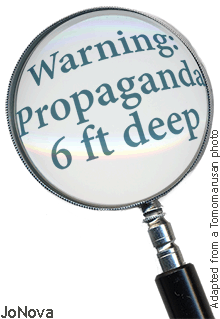
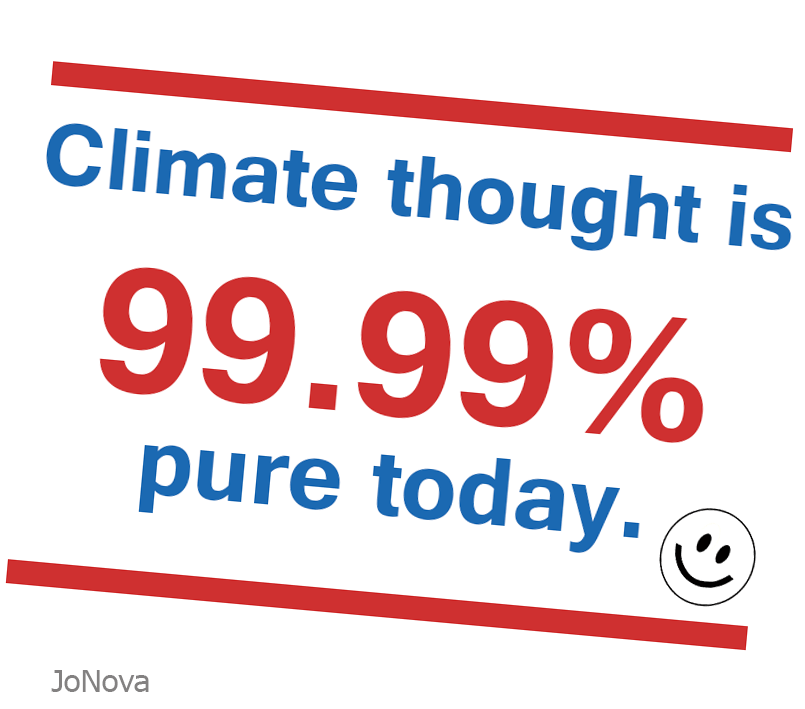

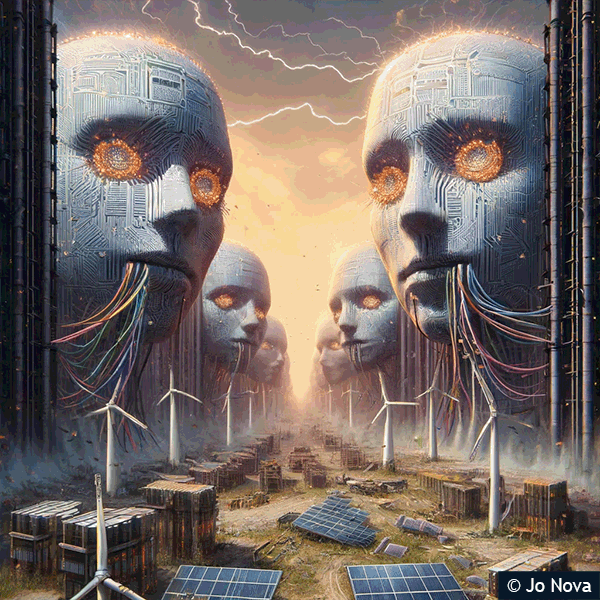













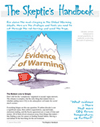
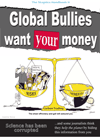
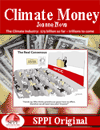




Recent Comments